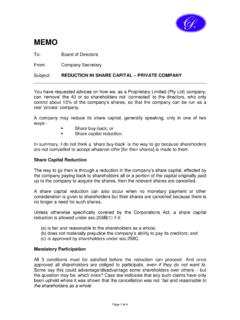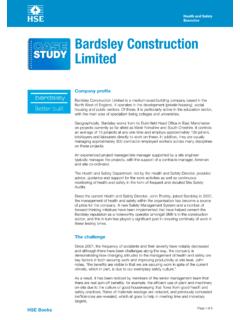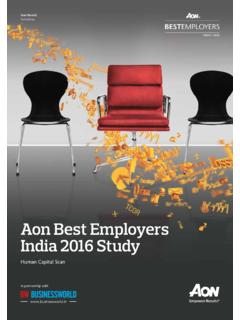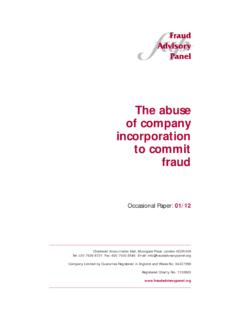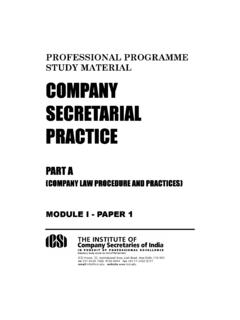Transcription of Incorporation - Taxbriefsonline
1 Incorporationtaxb-tg-bk-en-GBAugust 16, 2010 - 16:32370 All Rights ReservedPage 1 of 18 IntroductionThis section considers the advantages and drawbacks of using a private company when startingto trade, or later once a business has become established. It also summarises company formationprocedure. People starting in business generally risk nancial loss. As far as possible, they willwant to ensure that: Personal assets are safeguarded. The nancial position of the family is protected in the event of illness or death. Tax liabilities are minimised. Adequate nance can be obtained for establishing or expanding the as a limited company , rather than as an individual or in a partnership, sometimes helps toachieve these objectives. However, it can involve drawbacks and extra the right trading vehicle from the start will avoid the problems and costs of incorporatingor disincorporating.
2 But it is not always easy to decide, because it might be dif cult to forecasthow the business will develop. If there is any doubt about whether a company is the best vehicle,the business should be started as a sole trader or partnership. Tax legislation makes incorporationfar less costly than issuesTax is a particularly important issue when deciding whether or not to incorporate. The decisiondepends on the business and on the individual s personal and nancial circumstances. Individualcalculations have to be made. The entrepreneur has to weigh up the advantages of Incorporation (eg corporation tax at the small pro ts rate on up to 300,000 of pro ts) against the bene tof remaining a sole trader (eg lower national insurance contributions (NICs) than on director sremuneration paid by a company , and ease of extracting money).
3 Often, it is a question of howmuch sophisticated tax planning the individual wishes to several years of changes to tax rates, the basic rate of income tax, at 20%, is now 1%lower than the small pro ts rate of corporation tax of 21%. However, this rate will fall to 20%from April 2011 This has reduced the tax advantages of Incorporation for the smallest , where a sole trader would have signi cant pro ts within the 40% or 50% income taxband, Incorporation can still be bene an existing businessThis section discusses (on page 15, Transfer of an existing business to a company ) the proceduresfor transferring an existing business to a company . It can be bene cial to delay Incorporation ofa new business, because any trading losses in the opening years of an unincorporated businesscan be relieved against the owner s income tax for the three previous years.
4 Trading losseswould also prevent an incorporated business avoiding high NICs by paying dividends instead ofremuneration, so removing much of the tax bene t that can be gained by , Incorporation becomes desirable once pro ts reach a certain level, but incorporatingan existing business can result in: A large income tax assessment in the nal year of trading, depending on the accountingdate and other factors. Stamp duty land tax (SDLT) costs if freehold or leasehold property is transferred to acompany. Professional 16, 2010 - 16:32371 All Rights ReservedPage 2 of 18 These might outweigh any initial tax up a companyThe Companies Act 2006 introduced a number of provisions which have an impact on companyformations. The provisions of the Companies Act 2006 were implemented in stages.
5 Many of thechanges affecting the matters dealt with here were implemented from 1 October namesBefore preparing or submitting documents of Incorporation (see below), a check should be madeagainst the Index of company Names kept by the Registrar of Companies. This service is availableon the Companies House website at A name is not acceptable if it is the same as, or similar to, one already on the index. Some names require special approval. Objections to a name can be made on the basis that: It is similar to an existing company name being used by the person complaining. Its use in the UK could mislead by implying a connection to an existing of incorporationHere we are dealing only with the formation of companies on or after 1 October 2009, asregulated by the Companies Act documents which will need to be delivered to Companies House are:1.
6 Memorandum of association The memorandum is now more limited in scope than it was under previouslegislation It is a statement that the subscribers wish to form a company , agree to becomemembers and, where the company is to have a share capital, agree to take at leastone share each. Information about the proposed company s name, its registered of ce, limitedliability and the total number of shares taken by subscribers will be dealt with in theother registration documents (see below). An objects clause is not now required because under the 2006 Act every companyhas unrestricted objects. However, a company may choose to restrict its objects in Articles of associationRegulations arising under the 2006 Act contain model articles for each of the main typeof companies which may be formed.
7 These models are now treated as the default set ofArticles, but they may be modi ed if the company so Application for registrationThis states the company s name, whether liability is to be limited by shares or guaranteeand whether the company is to be public or 16, 2010 - 16:32372 All Rights ReservedPage 3 of 184. If the company is to have a share capital, a statement of its share capital and A statement of the intended registered of ce of the A statement of the rst directors and secretary (unless in the case of a private companythere is no secretary), together with a statement that the requirements of the 2006 Acthave been complied cate of incorporationWhen the Registrar has accepted the documents and company name, a certi cate of incorporationis issued to bring the company into formation specialistsReady-made and tailor-made companies can be bought from company formation is useful where a company is needed also often offer a free name costs Apart from any professional fees, a registration fee of 20 is payable, or 50 for same-dayincorporation.
8 If Incorporation is carried out electronically, the fee is 15, or 30 for same-day software is needed. The cost of a company from a formation agent starts at around 50, including the 20registration fee, for a basic documents needed for Incorporation can be obtained from Companies House on 0870 333 3636or through the Companies House website ( ), and model sets ofarticles of association can be obtained from legal costs arise from the need to maintain: Minute books for recording meetings of directors and shareholders. A book of share certi cates. Registers of members and share transfers. A register of the directors and secretary. Registers of debentures and other charges, if any. Books of account or appropriate computer software to record details of payments andreceipts, debtors and creditors, and other assets and liabilities.
9 A method of displaying the company name at the registered of ce and at all places ofbusiness. Printed letterheads, stationery, and other business documents, which must by law show thecompany s registered name. Most business documents must also show its registered of ceaddress, place of Incorporation and registered rst ve items are often combined into one register, which a company formation agent cansupply with the company package for an additional fee. It is not necessary to have a companytaxb-tg-bk-en-GBAugust 16, 2010 - 16:32373 All Rights ReservedPage 4 of 18seal, and small companies do not normally need one. Accounting records and business stationeryare necessary for any well-run business, whether or not costsIn addition to start-up costs, companies incur annual costs.
10 A limited company is obliged to le annual accounts with the Registrar of Companies. Thereare strict penalties if a private company fails to le accounts on time. For accounting periods starting after 5 April 2008, the ling date is nine months afterthe year end, or 21 months after Incorporation for the rst period. Penalties start at 150 for a delay of up to one month. Accounts one to three monthslate attract a penalty of 375, with 750 for a delay of three to six months and 1,500for a delay of more than six months. The penalties are doubled if accounts are led late a second time in succession. Small companies with turnover of million or less and a balance sheet total of not morethan million do not need an audit. Accounts still have to be prepared in the formrequired by the Companies Act and accounting regulations, which means professional feesare likely to be higher than for a sole trader.
